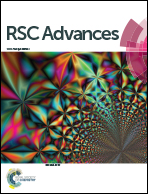Novel functional cisplatin carrier based on carbon nanotubes–quercetin nanohybrid induces synergistic anticancer activity against neuroblastoma in vitro†
Abstract
The synergistic effects of a three-functional hybrid material composed of methacrylic acid (MAA), quercetin (Q) and carbon nanotubes (CNT), with cisplatin (CP) was evaluated in human neuroblastoma cells. A three-functional hybrid material suitable for CP combination therapy was synthesized through the free radical-induced reaction between methacrylic acid, quercetin and carbon nanotubes. Two-functional materials were prepared and fully characterised by coupling CNT and MAA, as well as MAA and Q. A Folin–Ciocalteu assay was used to assess the functionalisation degree expressed as mg of Q per gram of materials and we found to be 2.33 for CNT_PMAA_Q and 2.01 for PMAA_Q. The anticancer activity of CNT_PMAA_Q was shown in human neuroblastoma cells using the Alamar blue cell proliferation assay. Successively, cells were treated with a combination of CP and the nanocomposite showing strong synergistic anticancer effects in neuroblastoma cells. These studies showed that nanoparticle formulations incorporating quercetin and carbon nanotubes are good candidates for CP synergistic treatment against neuroblastoma.


 Please wait while we load your content...
Please wait while we load your content...